Global transcriptional analysis suggests Lasiodiplodia theobromae pathogenicity factors involved in modulation of grapevine defensive response
- PMID: 27514986
- PMCID: PMC4981995
- DOI: 10.1186/s12864-016-2952-3
Global transcriptional analysis suggests Lasiodiplodia theobromae pathogenicity factors involved in modulation of grapevine defensive response
Abstract
Background: Lasiodiplodia theobromae is a fungus of the Botryosphaeriaceae that causes grapevine vascular disease, especially in regions with hot climates. Fungi in this group often remain latent within their host and become virulent under abiotic stress. Transcriptional regulation analysis of L. theobromae exposed to heat stress (HS) was first carried out in vitro in the presence of grapevine wood (GW) to identify potential pathogenicity genes that were later evaluated for in planta expression.
Results: A total of 19,860 de novo assembled transcripts were obtained, forty-nine per cent of which showed homology to the Botryosphaeriaceae fungi, Neofusicoccum parvum or Macrophomina phaseolina. Three hundred ninety-nine have homology with genes involved in pathogenic processes and several belonged to expanded gene families in others fungal grapevine vascular pathogens. Gene expression analysis showed changes in fungal metabolism of phenolic compounds; where genes encoding for enzymes, with the ability to degrade salicylic acid (SA) and plant phenylpropanoid precursors, were up-regulated during in vitro HS response, in the presence of GW. These results suggest that the fungal L-tyrosine catabolism pathway could help the fungus to remove phenylpropanoid precursors thereby evading the host defense response. The in planta up-regulation of salicylate hydroxylase, intradiol ring cleavage dioxygenase and fumarylacetoacetase encoding genes, further supported this hypothesis. Those genes were even more up-regulated in HS-stressed plants, suggesting that fungus takes advantage of the increased phenylpropanoid precursors produced under stress. Pectate lyase was up-regulated while a putative amylase was down-regulated in planta, this could be associated with an intercellular growth strategy during the first stages of colonization.
Conclusions: L. theobromae transcriptome was established and validated. Its usefulness was demonstrated through the identification of genes expressed during the infection process. Our results support the hypothesis that heat stress facilitates fungal colonization, because of the fungus ability to use the phenylpropanoid precursors and SA, both compounds known to control host defense.
Keywords: Botryosphaeria dieback; Fungal gene expression; Graevine vascular diseases; Melanin; RNA-seq; RT-qPCR; Transcriptome; Vitis vinifera.
Figures
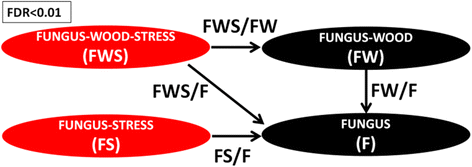
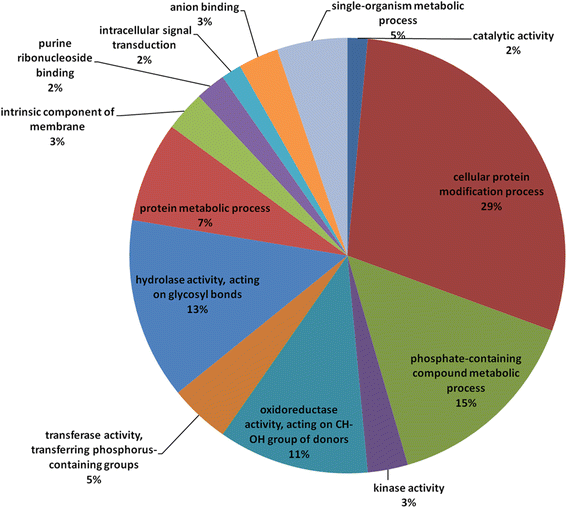
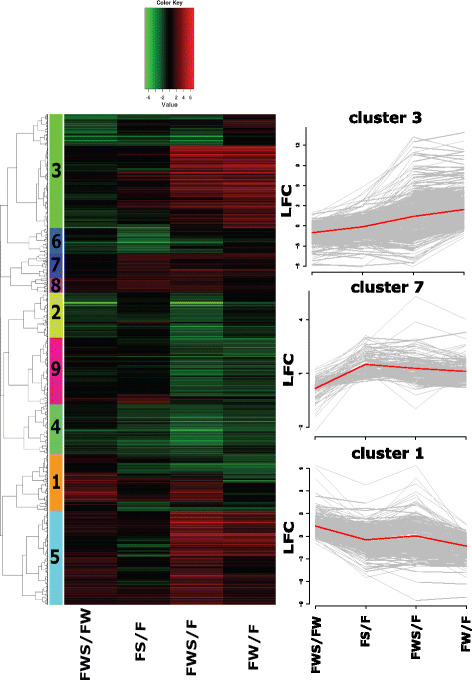
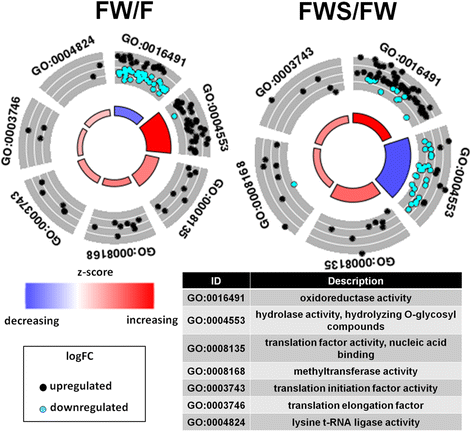
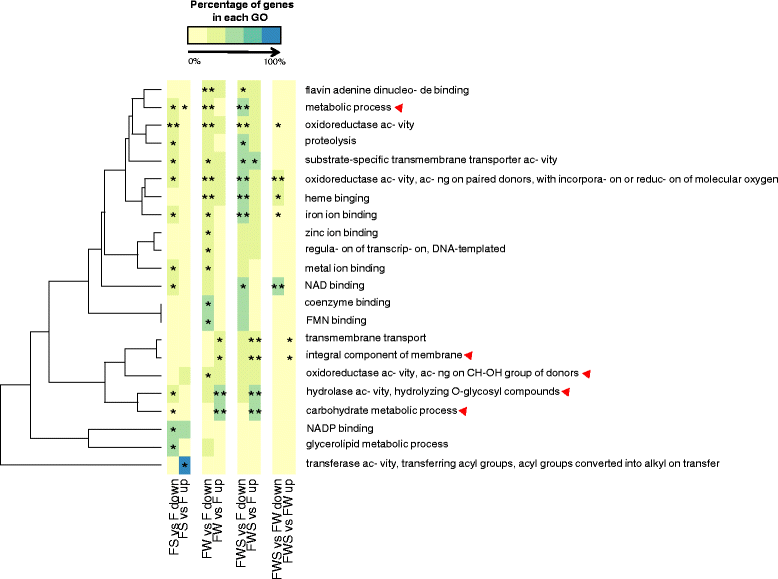
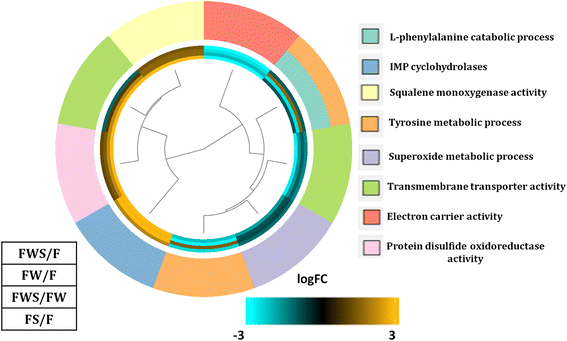
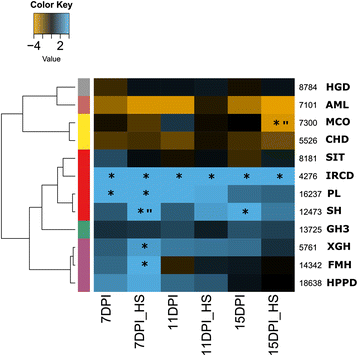
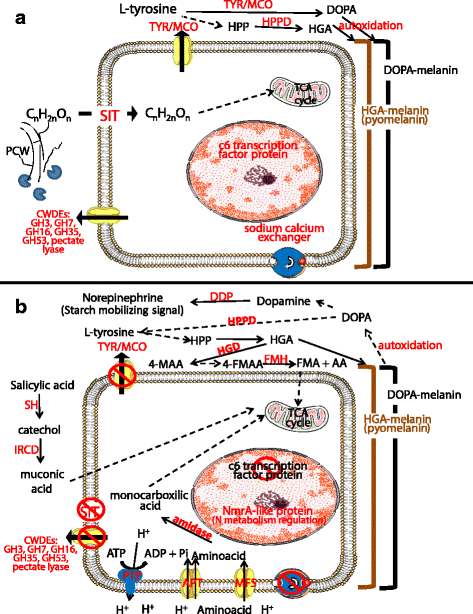


Similar articles
-
A multi-omics analysis of the grapevine pathogen Lasiodiplodia theobromae reveals that temperature affects the expression of virulence- and pathogenicity-related genes.Sci Rep. 2019 Sep 11;9(1):13144. doi: 10.1038/s41598-019-49551-w. Sci Rep. 2019. PMID: 31511626 Free PMC article.
-
Dual RNA Sequencing of Vitis vinifera during Lasiodiplodia theobromae Infection Unveils Host-Pathogen Interactions.Int J Mol Sci. 2019 Dec 3;20(23):6083. doi: 10.3390/ijms20236083. Int J Mol Sci. 2019. PMID: 31816814 Free PMC article.
-
Transcriptional response of grapevine to infection with the fungal pathogen Lasiodiplodia theobromae.Sci Rep. 2019 Mar 29;9(1):5387. doi: 10.1038/s41598-019-41796-9. Sci Rep. 2019. PMID: 30926851 Free PMC article.
-
Epigenetic regulation and beyond in grapevine-pathogen interactions: a biotechnological perspective.Physiol Plant. 2025 Mar-Apr;177(2):e70216. doi: 10.1111/ppl.70216. Physiol Plant. 2025. PMID: 40234103 Free PMC article. Review.
-
Epigenetic regulation of nuclear processes in fungal plant pathogens.PLoS Pathog. 2023 Aug 3;19(8):e1011525. doi: 10.1371/journal.ppat.1011525. eCollection 2023 Aug. PLoS Pathog. 2023. PMID: 37535497 Free PMC article. Review.
Cited by
-
Dual RNA-Seq Reveals Temperature-Mediated Gene Reprogramming and Molecular Crosstalk between Grapevine and Lasiodiplodia theobromae.J Fungi (Basel). 2023 Dec 14;9(12):1197. doi: 10.3390/jof9121197. J Fungi (Basel). 2023. PMID: 38132797 Free PMC article.
-
A multi-omics analysis of the grapevine pathogen Lasiodiplodia theobromae reveals that temperature affects the expression of virulence- and pathogenicity-related genes.Sci Rep. 2019 Sep 11;9(1):13144. doi: 10.1038/s41598-019-49551-w. Sci Rep. 2019. PMID: 31511626 Free PMC article.
-
Systemic Identification and Functional Characterization of Common in Fungal Extracellular Membrane Proteins in Lasiodiplodia theobromae.Front Plant Sci. 2021 Dec 20;12:804696. doi: 10.3389/fpls.2021.804696. eCollection 2021. Front Plant Sci. 2021. PMID: 34987541 Free PMC article.
-
Machine learning prediction of novel pectinolytic enzymes in Aspergillus niger through integrating heterogeneous (post-) genomics data.Microb Genom. 2021 Dec;7(12):000674. doi: 10.1099/mgen.0.000674. Microb Genom. 2021. PMID: 34874247 Free PMC article.
-
Comparative genome and transcriptome analyses reveal adaptations to opportunistic infections in woody plant degrading pathogens of Botryosphaeriaceae.DNA Res. 2018 Feb 1;25(1):87-102. doi: 10.1093/dnares/dsx040. DNA Res. 2018. PMID: 29036669 Free PMC article.
References
-
- Allen CD, Macalady AK, Chenchouni H, Bachelet D, McDowell N, Vennetier M, et al. A global overview of drought and heat-induced tree mortality reveals emerging climate change risks for forests. For Ecol Manage. 2010
-
- Teskey R, Wertin T, Bauweraerts I, Ameye M, McGuire MA, Steppe K. Responses of tree species to heat waves and extreme heat events. Plant Cell Environ. 2014 - PubMed
-
- Allen CD, Breshears DD, McDowell NG. On underestimation of global vulnerability to tree mortality and forest die-off from hotter drought in the Anthropocene. Ecosphere. 2015
-
- Oliva J, Stenlid J, Martínez-Vilalta J. The effect of fungal pathogens on the water and carbon economy of trees: implications for drought-induced mortality. New Phytol. 2014 - PubMed
-
- Desprez-Loustau M. Interactive effects of drought and pathogens in forest trees. Ann For Sci. 2006
Publication types
MeSH terms
Substances
LinkOut - more resources
Full Text Sources
Other Literature Sources
Molecular Biology Databases

